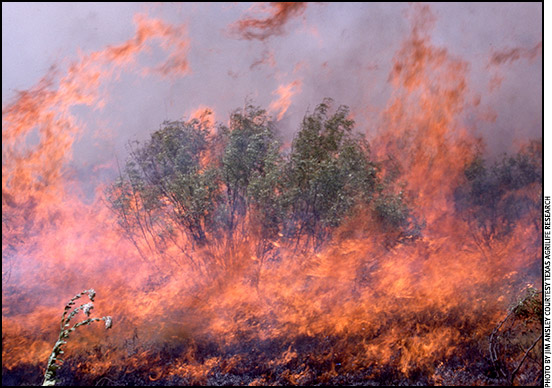
One-two Punch
Combined treatment most effective for brush management.
Sometimes a one-two punch is needed to control brush effectively on rangeland, according to a Texas AgriLife Research brush management scientist.
"Two of the most important tools for brush management are the use of prescribed fire and application of herbicides," said Jim Ansley, AgriLife Research scientist at Vernon. "Often these two are thought of as separate stand-alone treatments, but many times they are most effective when used together as part of a long-term brush management plan."
Brush can spread across a ranch, reducing grass for grazing, if it is left unmanaged, Ansley said. Greater encroachment is generally caused by a reduced frequency of natural fires and the spread of seeds by grazing cattle and wildlife. When mesquite or juniper cover exceeds 30%, the production of warm-season grasses is severely reduced.
At that point, it is time to manage the brush, he said. The first law of brush management is: No single treatment provides a final solution. Brush management is a continual process, due to regrowth of old plants and emergence of new plants.
"Brush management, particularly for mesquite, is all about managing regrowth," Ansley said. "Regrowth will dominate your life unless you develop a plan to successfully manage it."
There are several levels to controlling brush, rootkill, partial topkill, topkill and canopy reduction. Ansley discussed the various methods that can be used, the effectiveness, the costs and the long-term effects during a one-hour webinar presentation, "Integrating Fire and Herbicides," on April 5. This webinar, as well as others in the 2011 and 2012 series, can be accessed at http://naturalresourcewebinars.org.
He discussed timing and method of application of the various controls — herbicides, mechanical chaining or grubbing and fire — and how they vary depending on what invasive plant is to be controlled.
This webinar is a part of a series offered by the Texas AgriLife Extension Service's ecosystem science and management unit as a way to earn Texas Department of Agriculture continuing education units online, according to Brittany Grube, graduate assistant and webinar coordinator.
The webinars are scheduled from noon to 1 p.m. every first Thursday of the month, Grube said.
The webinars are free to participants not seeking continuing education units. However, if participants would like to receive Texas Department of Agriculture continuing education units, there is a $10 fee. Ansley's presentation qualified for one integrated pest management continuing education unit.
For more information on the webinars, contact Grube.
For more information on brush management, contact Ansley by email or go to his website, http://vernon.tamu.edu/center_programs/brush/index.php.
Editor's note: This article, written by Kay Ledbetter, is adapted from a release from Texas A&M AgriLife Communications.











